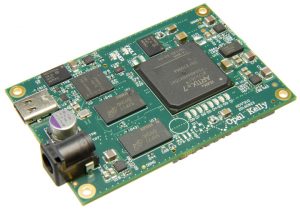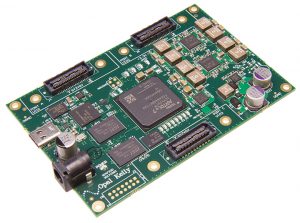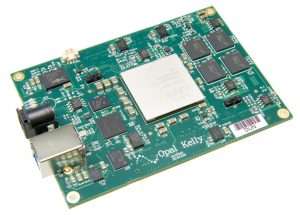What are Production-Ready Integration Modules and How Do I Benefit from Them?
When it comes to creating and evaluating embedded solutions, most if not all engineers will be familiar with an evaluation board. However, they may not be familiar with the applications and advantages of production-ready integration modules.
In this blog we are going to look at Opal Kelly’s production-ready integration modules, discuss their applications in the evaluation, integration, and acceleration domains, and examine some of the selection criteria and benefits.
What’s an Evaluation Board?
Let’s start with an explanation of how production-ready integration modules differ from evaluation boards. The primary difference relates to the potential use cases. Evaluation boards are created by semiconductor device manufacturers and their distributors to achieve a “design win,” often subsidizing the cost of the development and production of the board to make it attractive to customers.
While this makes evaluation boards useful for prototyping and initial concepts, the short-term design objectives undertaken in the design of the evaluation boards (e.g. minimum time to market to ensure maximal design wins) often ensures evaluation boards are not suitable for inclusion in the finished product. This unsuitability stems from the use of bespoke, often large form factors, limited interfacing, and no consideration for the product life cycle (e.g. obsolescence).
Applications of Production-Ready Integration Modules
Opal Kelly production-ready Integration modules are designed to be used for three main applications: integration, evaluation, and acceleration.

Integration: If there is a desire to reduce the non-recurring expense and design risk inherently accompanying a new design, deploying an Opal Kelly integration module provides a significant advantage. Choosing a reliable, widely deployed platform greatly increases engineering confidence of a new project start.
As an example of the NRE reduction possible when using Integration modules, one case study in which the USPS used Opal Kelly integration modules in place of a bespoke design identified an estimated 66% cost savings over developing a solution in-house.
The FrontPanel SDK stands as a single, common platform for modules ranging from low-density FPGAs used for simple glue logic up to high-density, high-performance FPGAs and memory systems designed for advanced data acquisition and processing requirements. A variety of form factors and interface capabilities makes the advantages of the FrontPanel SDK available to many applications.

When designing an evaluation platform with our modules, a variety of interface options are available to suit most any application. For high-speed, high-performance peripherals such as image sensors, digital communications, and high speed data acquisition, FMC or SYZYGY interconnect coupled with DDR3 memory and dense FPGAs allow a lot of room for experimentation and prototyping.
At the low end, Digilent Pmod and SYZYGY interconnect enable more affordable solutions with smaller FPGAs.
Lest we focus too much on device evaluation, another excellent application is the evaluation of intellectual property (IP) such as interface & interconnect, communications, audio and video CODECs, and other such “IP cores”. Providing a demonstration platform for the evaluation of IP can help the customer understand the capabilities and functionality of the IP in a real, functional setting. Using off-the-shelf modules dramatically reduces the effort required to deploy such a system, allowing IP designers to focus on their own value-add.

FPGA design and development has traditionally been thought to have a steep learning curve which acts as a barrier to entry, preventing many from leveraging the advantage of programmable logic. However, High Level Synthesis now makes it possible to develop programmable logic applications using C, C++, and OpenCL. These high-level synthesis applications can be combined easily with FrontPanel allowing for a reduced development flow both in communication and application.
Using HLS in this manner allows the developer to leverage the ability to work at a higher level of abstraction, and removes the need to re-implement algorithms in RTL which takes considerable time.
Selection Criteria
Opal Kelly production-ready integration modules are designed from the very start to be integrated directly into a final product. Considerable attention is focused on the product life cycle, component selection, engineering data pack availability (e.g. mechanical drawings, reference designs, SDK documentation), and obsolescence management. In addition to simplified product management, integration modules also provide three key engineering aspects: a compact form factor, flexible connectivity, and integration support. Below are some of the dimensions that should be considered when selecting a module:
- Interface Speed – Does your application require sustained data transfer or just occasional control or telemetry?
- On-Board Memory – Some processing tasks such as image processing require significant available memory and data acquisition may use large memories to provide buffers to avoid missing data.
- I/O Count – If you need more interface pins to attach to peripherals, that often comes with a larger FPGA package, denser expansion connectors, and a larger module form factor.
- Transceiver I/O – Some applications require SERDES transceivers.
- Interface Type – If you need compatibility with multiple off-the-shelf peripherals, SYZYGY or FMC interconnect may be preferred.
Customer Benefits
Of course, selection of an integration module requires careful consideration of the use case. There are numerous benefits of using the appropriate modules including,
- Accelerated time-to-market – No associated development lead time with creating hardware and high-speed connectivity solution.
- Resource optimization – Frees the developer to focus on their core competence and value-added activities.
- Lower cost – In production, an off-the-shelf module can also be significantly less expensive in cost of goods sold (COGS) and greatly simplify supply chain management. These benefits are evident at low and even moderate production volumes.
- Reduced supply chain complexity.
- Reduced software maintenance – Development and maintenance of the software communication framework between the host and the module is handled by a third party.
- Multi-platform support – Out-of-the-box support for Windows, macOS, and Linux on both x86 and ARM architectures.
The selected module may have a cost differential between what one would expected for an evaluation board. This is more than recovered by the reduction in engineering effort required for connectivity thanks to the FrontPanel SDK and the considerable design analysis and product life cycle management which goes in to Opal Kelly integration modules.
